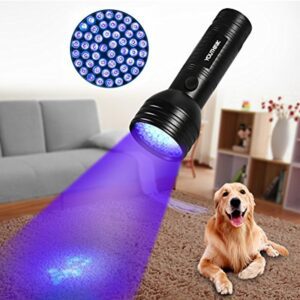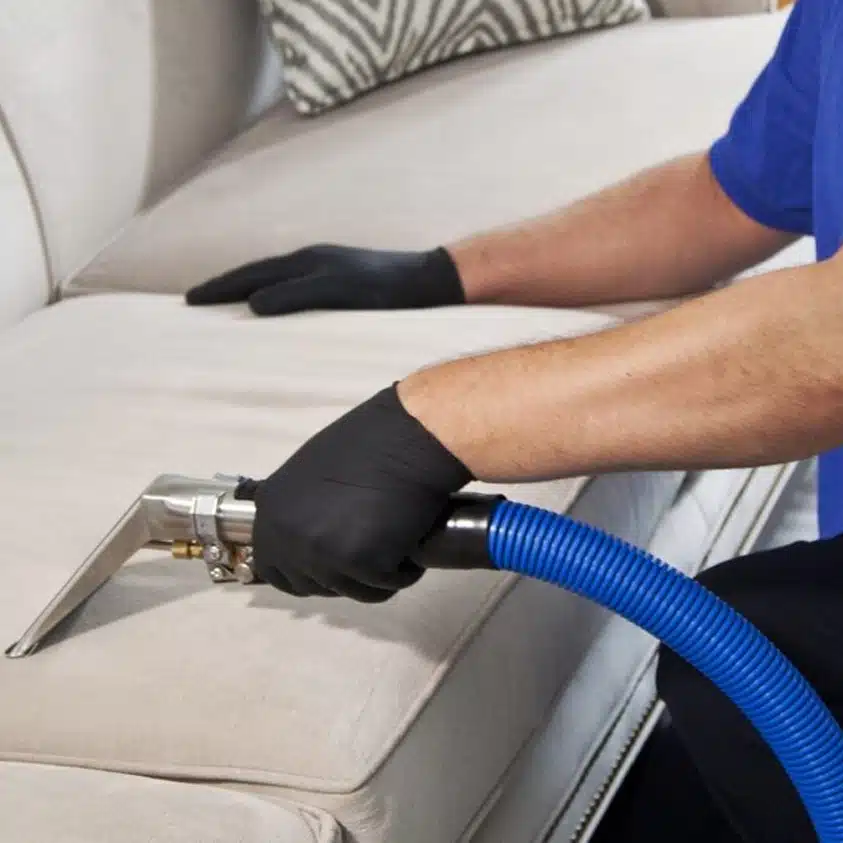Table of Contents
How to Detect Urine on Carpet: Your Ultimate Guide.
Welcome to this comprehensive guide on how to detect urine on carpet. Identifying and treating urine stains promptly is crucial for maintaining a clean, fresh home.
 This article will walk you through how to detect human urine, cat urine, dog urine, and other pet urine on your carpet.
This article will walk you through how to detect human urine, cat urine, dog urine, and other pet urine on your carpet.
We will also discuss some of the tools you can use to accomplish this.
Understanding the Challenge
Detecting urine on carpets can be an incredibly perplexing and frustrating task. That’s due to the intricate nature of carpets and the perplexing properties of urine.
Carpets, particularly those with profound piles or dense fibers, are meant to offer both aesthetic appeal and comfort. However, these very attributes also make them incredibly proficient at hiding dirt and stains.
The fibers of the carpet can absorb and cloak the urine, enabling it to penetrate deep down to the padding, and even the floor beneath. This renders the urine immensely difficult to locate and eliminate completely. In such cases, expert carpet cleaning company become essential for thorough cleaning and odor removal.
Composition of urine
Urine, regardless of whether it originates from humans or pets, is not a simple liquid. It is a complex compound of water, urea, salts, and various other substances. When it first hits your carpet, it might not seem to be significant. However, as it dries, it undergoes a major transformation. It leaves behind tiny crystals that are masters of disguise—they not only stain your carpet but also release a persistent, pungent odor that’s hard to ignore.
Other issues
The complication is compounded when grappling with pet urine. Animals frequently revisit the same spot to urinate, causing the urine to accumulate over time. Moreover, some pets tend to urinate in obscure or hard-to-reach locations, exacerbating detection.
The smell of urine can also permeate the surrounding environment, masking the odor over time and rendering it challenging for household members to detect. Nevertheless, visitors will undoubtedly notice the odor as soon as they enter the home.
In short, the task of detecting urine on carpets involves dealing with a stain that is not only hard to see but also deeply set and capable of producing a stubborn odor. Despite these challenges, with the right approach and tools, it’s a task that can be successfully accomplished. For residents in Utah, professional carpet cleaning services offer effective solutions to tackle such tough stains and odors
Common Signs of Urine on Carpet: A Closer Look
There are several common signs that can help you detect urine on carpet. Paying attention to these signs will make it easier to locate and treat urine stains, ensuring a cleaner, fresher home. Let’s take a closer look at the various indicators of urine on carpets.
Odor
The most noticeable sign of urine on carpets is often the smell. Human urine, as well as pet urine, emits a strong, slightly sweet odor that can become more pungent over time. This change in smell is caused by bacteria breaking down the urea present in urine. The scent can vary depending on the individual, the animal species, and even the diet. However, it is usually distinct enough to be recognized as urine.
Visible Stains
Urine on carpets can leave visible stains that vary in color and intensity. Fresh urine stains typically appear as a wet, darker spot on the carpet, while older stains can range from yellow to brown.
Urine stains are easier to detect on light colored carpets, but they can be harder to spot on darker or patterned carpets. Check your carpet carefully and regularly, especially in pet-friendly areas, to identify and treat any visible stains.
Dampness or Moisture
Another indicator of urine on carpets is dampness or moisture. When urine soaks into a carpet, it can penetrate the fibers and reach the carpet padding. This can result in a damp or squishy feeling when you walk over the affected area.
If you notice a change in the texture of your carpet or sense an unusual dampness, it’s worth investigating further to determine whether there’s urine present.
Discoloration or Fading
Urine can cause discoloration or fading of your carpet, particularly if left untreated for extended periods. The acidic nature of urine, especially in pet urine, can break down carpet fibers and dyes, leading to visible discoloration.
If you notice any areas of your carpet that appear faded or discolored, it could be a sign of urine damage.
Crystallization or Residue
As urine dries, it can leave behind crystallized residue. These crystals can be a sign of urine on carpets, especially when combined with other indicators like odor or visible stains. Investigate any powdery or gritty residue on your carpet to determine if it’s caused by urine.
By paying close attention to these common signs of urine on carpets, you’ll be better equipped to detect and treat any urine stains. Prompt action is essential in preventing long-term damage and persistent odors, ensuring a clean and pleasant home environment.
Tools for Detecting Urine on Carpet
Several tools are available for detecting urine on carpets. is a task that often arises, especially for pet owners or parents of young children. Effective tools range from your nose to high-tech equipment. While your nose is a handy tool, often, more specific methods are required for precise detection.
Here, we’ll explore various tools, from natural olfactory senses to professional-grade UV lights and simple household solutions.
Using Your Nose To Detect Urine On Carpet
The human nose, while seemingly simplistic, is an impressive detection tool. It can often identify the distinct smell of urine, be it human or pet urine, marking the first sign of a potential issue. Fresh urine carries a somewhat sweet, sharp scent, which can intensify and become increasingly unpleasant as the urine dries and bacteria break it down.
However, while helpful, the nose is not a foolproof tool. Pinpointing the exact location of urine based solely on smell can be a challenge. Odors can be subjective, and what one person finds noticeable may be less apparent to another. Moreover, continual inhalation of urine can lead to potential health concerns, especially for those with respiratory conditions or allergies.
Using Tools To Detect Urine On Carpet
In our technology-driven age, several advanced tools can aid in detecting urine on carpets, providing precise and health-friendly alternatives.
Blacklights
UV blacklights are one such tool, with professionals often opting for high-intensity versions for their superior detection capabilities. These black lights cause urine stains to fluoresce, illuminating otherwise hidden or faint stains.
This tool is equally effective on all types of urine—dog, cat, or human. For optimal results, darken the room completely before using a UV light. However, be aware that other substances can also fluoresce under UV light, so it’s wise to use additional detection methods for confirmation.
Moisture detectors
Moisture detectors are another useful tool for detecting urine, particularly older, dried stains. By identifying increased moisture levels in the carpet, these devices can locate spots where urine has been absorbed. This is particularly beneficial for finding stains that no longer produce a smell but can continue to damage your carpet.
Household solutions
Finally, household solutions, such as vinegar and water, offer a low-tech but effective detection method. When vinegar reacts with urine, it produces a visible foam, indicating the urine’s presence. This method, while not as precise as others, is an economical and readily available option for homeowners.
In Summary
Detecting urine on carpets is a vital task for maintaining a hygienic and pleasant environment in your home. While your nose can provide a valuable initial alert, the use of professional-grade tools like high-intensity UV blacklights or moisture detectors, or even a simple vinegar solution, can ensure thorough detection and treatment.
Understanding Different Types of Urine
An often-overlooked aspect in the quest to detect urine on carpet is understanding the unique characteristics of different types of urine. Whether you’re grappling with how to detect human urine, dog urine, or cat urine on carpet, each type presents its own set of challenges.
Human Urine
Human urine is a byproduct of our body’s filtration system. Our kidneys, with the help of tiny filtering units called glomeruli, sift through our blood, extracting waste and excess water to form urine. Human urine is basically similar in composition to pet urine.
The color of human urine ranges from clear to a pale yellow to a darker amber. Human secretions based on diet medications, or hydration levels will affect urine coloration. Its odor is usually mild but can become stronger over time as bacteria break it down, converting urea into ammonia. This process can make aged human urine stains particularly challenging to remove.
Dog Urine
Dog urine is typically more acidic than human urine, and it contains a higher concentration of nitrogen compounds. These characteristics contribute to a stronger odor and greater potential to damage carpets.
Dogs, particularly males, often use urine marking as a way to communicate, leading to frequent and sometimes recurring spots of contamination. Also, the warm, dark environment in the carpet fibers provides a suitable breeding ground for bacteria, which can exacerbate the odor over time.
Cat Urine
Detecting cat urine on carpet can be particularly challenging. Cats are known for their strong, pungent urine, which contains a high concentration of certain chemicals like uric acid, urobilin/urobilinogen, and ammonia. These chemicals can penetrate deeply into carpet fibers, making the stain more stubborn and the odor particularly hard to remove.
Moreover, cat urine contains a unique pheromone called felinine, which cats use to mark their territory. This pheromone can contribute to the re-soiling behavior, as cats tend to revisit and re-mark the same spot, leading to layers of contamination that can be difficult to detect and clean effectively.
Rabbit Urine
We will mention rabbit urine here also. Although not common it is often found on residential carpets. Rabbit urine is typically pale in color but can change based on diet and hydration. It is usually less acidic than cat or dog urine but can still cause stains and odors if not addressed promptly.
Rabbit urine varies is its consistency, from watery to sludgy. And it is affected by diet. Rabbits on a high calcium diet will excrete a thick, sludgy urine that can be particularly difficult to clean up.
So, detecting urine on carpets is not a one-size-fits-all task. And knowing the special characteristics of different types of urine can help to determine the best methods for detection and subsequent cleaning.
The Cleaning Process
Once you’ve mastered how to detect urine on carpet, the next vital step is cleaning it promptly. This step is just as crucial, if not more so, as letting urine sit can lead to stubborn stains and persistent odors. The cleaning process often involves using specialized cleaning solutions for pet urine treatment or professional pet urine removal for more severe cases. Let’s delve into this in more detail.
Why Enzymes are Essential.
Enzyme-based cleaning solutions are the gold standard when it comes to pet urine removal treatment. But why are enzymes so important?
Enzymes are proteins that act as catalysts, speeding up chemical reactions. They are highly specific, meaning each enzyme is designed to react with a particular substance. In the case of urine, there are certain enzymes designed to react with the compounds found in urine, such as urea and uric acid. When they come into contact with these compounds, they break them down into simpler substances that don’t have the unpleasant odor associated with urine.
For instance, the enzyme urease can break down urea (a major component of urine) into ammonia and carbon dioxide—substances that are much easier to remove from your carpet.
An effective enzyme cleaner will have a mix of enzymes to deal with the different compounds in urine. Therefore, whether you’re dealing with human urine or pet urine on your carpet, an enzyme-based cleaner is your best bet.
The Importance of Time
When it comes to urine stains and odors, time is of the essence. The longer urine sits on the carpet, the more it will soak into the fibers and the carpet padding underneath. This can lead to persistent odors and stains that are more difficult to remove.
Moreover, over time, the compounds in the urine start to break down due to the action of bacteria. This breakdown can lead to the production of ammonia and other compounds, which can further intensify the smell of the urine
Therefore, as soon as you detect urine on your carpet—be it human urine, dog urine, cat urine, or any other pet urine—it’s essential to start the cleaning process immediately.
The Cleaning Process: Step-by-Step
Here’s a general step-by-step process to clean urine from your carpet:
Blot the Spot:
If the urine is still wet, use a clean cloth or paper towels to blot up as much of it as you can. Remember, don’t rub, as this can spread the urine and push it deeper into the carpet.
Apply Enzyme Cleaner:
Apply a generous amount of an enzyme-based cleaner to the spot. Make sure to follow the instructions on the bottle, as different cleaners may have different application methods.
Let it Sit:
Allow the cleaner to sit for the time recommended on the bottle. This gives the enzymes enough time to break down the urine compounds.
Blot Again:
After the cleaner has sat for the appropriate amount of time, blot up the cleaner with a clean cloth or paper towel.
Rinse and Dry:
Rinse the spot with cool water and blot up the water with a clean cloth or paper towel. Then, let the spot air dry or use a fan to speed up the drying process.
For stubborn stains or widespread contamination, it may be necessary to repeat this process several times, or even consider hiring professional pet urine removal services.
Professional Pet Urine Removal
Professional cleaning services have specialized equipment and solutions to deep clean your carpet and remove all traces of urine. This can be especially helpful in severe cases, where the urine has soaked through to the carpet padding or for older stains that have set in.
Regular maintenance is also crucial.
Regularly checking for and cleaning up any accidents as soon as they occur can help prevent the urine from seeping deeper into the carpet and padding, making the removal process easier and more successful.
Vacuuming your carpet regularly can also help keep it clean and fresh. A clean carpet is easier to inspect and allows for quicker detection of any new accidents.
In situations where the contamination is severe or the stain is old and set in, professional pet urine removal services may be necessary. These services have the tools, products, and expertise to deep-clean your carpet, ensuring all traces of urine are eliminated.
Conclusion
In conclusion, the cleaning process for urine stains on carpets involves a thorough understanding of how to use cleaning tools effectively and the importance of time and enzymes in this process.
When using an enzyme cleaner, ensure it is applied generously and allowed to sit for the recommended time. The enzymes need time to break down the urine compounds effectively. Rushing this process can result in a less-than-satisfactory outcome.
References
[1] National Institute of Diabetes and Digestive and Kidney Diseases. (2017). Your Kidneys & How They Work. https://www.niddk.nih.gov/health-information/kidney-disease/kidneys-how-they-work
[2] Barker, S. B., & Barker, R. T. (1988). The human-canine bond: Closer than family ties? Journal of Mental Health Counseling, 10(1), 46-56. [3] Hart, B. L
[3] Enzyme Wizard. (n.d.). Why enzymes & how do they work? Retrieved from https://enzymewizard.com/why-enzymes-how-do-they-work/
[4] Ijaz, M. K., Brunner, A. H., Sattar, S. A., Nair, R. C., & Johnson-Lussenburg, C. M. (1985). Survival characteristics of airborne human coronavirus 229E. Journal of General Virology, 66(12), 2743-2748.
[5] Carpet and Rug Institute. (n.d.). Spot Solver. Retrieved from https://www.carpet-rug.org/spot-solver/
Frequently Asked Questions (FAQs)
- What are the signs of urine on my carpet?
The most common signs of urine on your carpet include a strong, slightly sweet odor, yellow or brown visible stains, and changes in the texture of the carpet, such as dampness.
- How can I detect urine on my carpet?
You can detect urine on your carpet using your nose, UV blacklights, moisture detectors, or homemade solutions like vinegar and water.
- What’s the importance of enzymes in cleaning urine from carpets?
Enzymes are proteins that act as catalysts in chemical reactions. In the case of urine, specific enzymes can break down compounds such as urea and uric acid into simpler substances that don’t produce an unpleasant odor. This makes enzyme-based cleaners highly effective in pet urine treatment.
- How soon should I clean urine from my carpet?
It’s crucial to clean urine from your carpet as soon as possible. The longer the urine sits on the carpet, the more it soaks into the fibers and carpet padding, leading to persistent odors and difficult-to-remove stains.
- How can I clean urine from my carpet?
You can clean urine from your carpet by blotting the spot, applying an enzyme cleaner, allowing it to sit, blotting again, then rinsing and drying the spot. For severe or stubborn stains, consider hiring professional pet urine removal services.
- What’s the difference between human urine and pet urine on carpets?
Different species’ urine has unique characteristics. For example, dog urine has a strong odor and acidic nature that can be harmful to carpets, while cat urine has a high concentration of certain chemicals that can lead to stubborn stains. Knowing the type of urine helps in effectively treating and cleaning the carpet.
- Why might I need professional pet urine removal?
In severe cases, where the urine has soaked through to the carpet padding or for older, set-in stains, professional pet urine removal services can be helpful. They have specialized equipment and solutions to deep clean your carpet and remove all traces of urine.
We hope this guide from https://ablejan.com empowers you to detect and tackle urine stains on your carpet. If you need further assistance or have any questions, feel free to contact us at 801-368-0705. We’d also love to hear from you about your experiences or tips.





